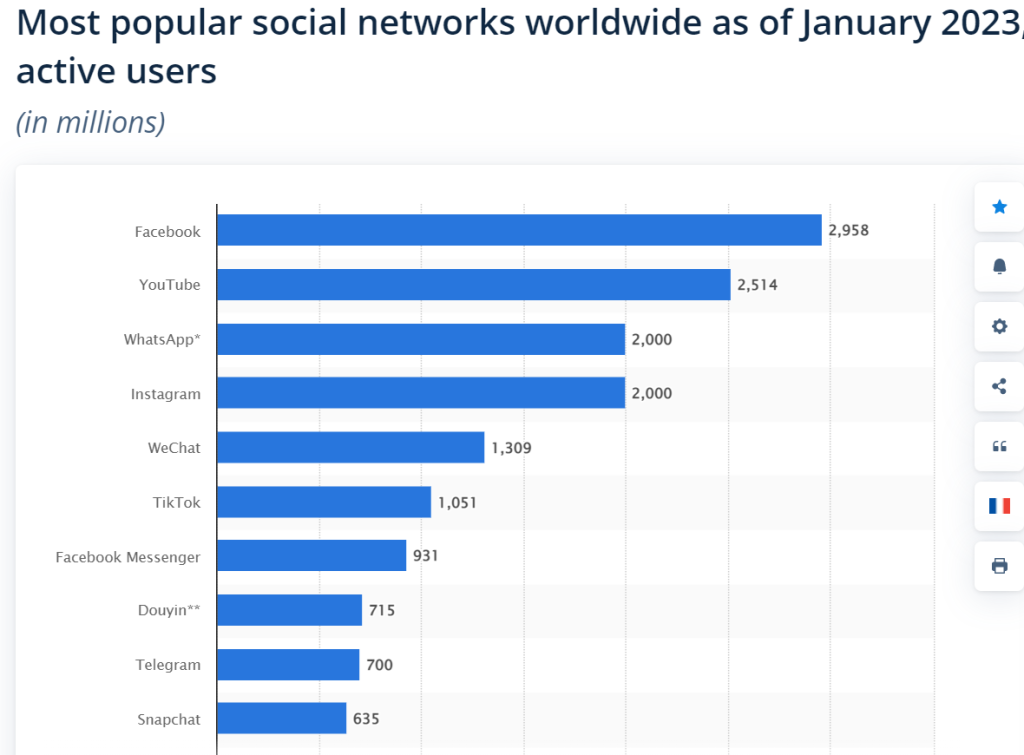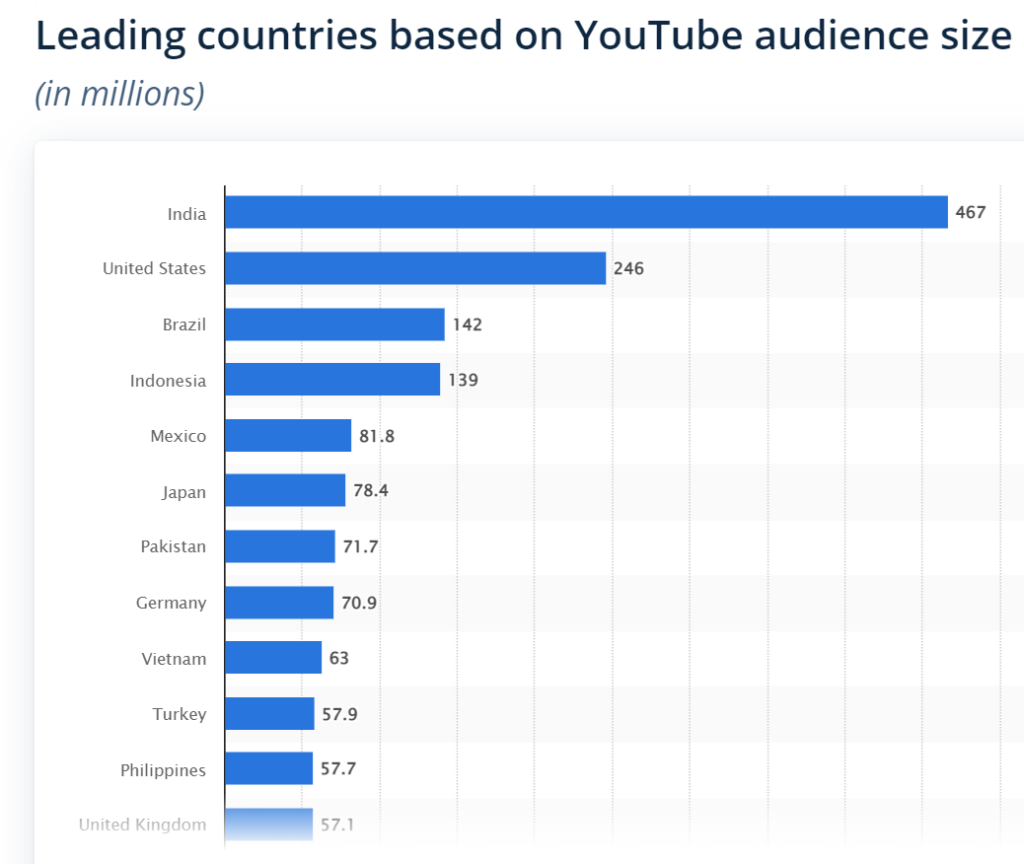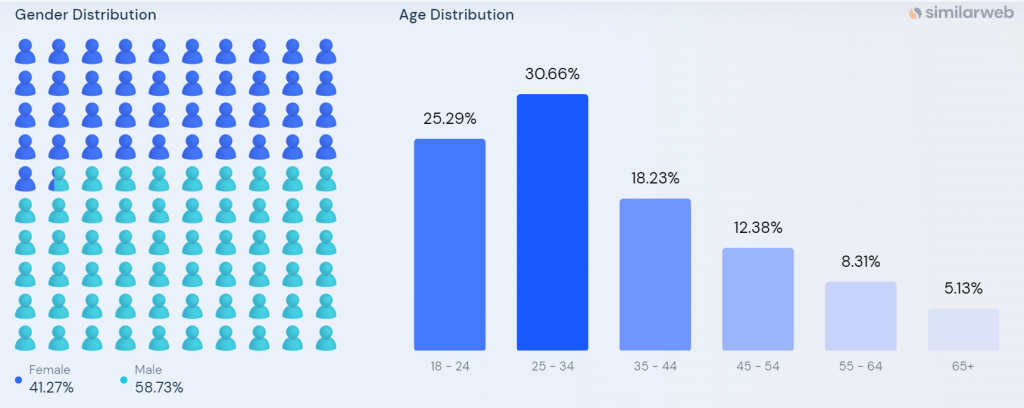For a company looking to advertise digitally, your first choice might be the biggest, most popular online video platform-YouTube- a place you know would offer your ads reach, engagement and subsequently a good ROI. This advertising works best if your brand has a video ad and you’re targeting a tech savvy, young audience.
While YouTube advertising might seem like it could work wonders for your brand, knowing whether its the right fit for your is exactly what you need to understand. Read our Media Kundli to know the types of ads, the in-depth targeting options and multiple benefits of advertising on this popular platform.
Top 3 YouTube Advertising Facts
Here are the major YouTube data-
- YouTube comes no 2 globally, ranked by the metric of Monthly Active Users and is preceded by Facebook, which ranks no 1 globally. The Monthly Active Users of YouTube is 2.5 Million and Facebook is 2.9 Million, as of Jan 2023. (Source- Statista)
- No of daily visits on YouTube is 30 Billion, as of Feb 2023. (Source- Similarweb)

Usage and demographics– As of Jan 2023, India has the most YouTube users, with 467 Million users. The number of YouTube users in India is estimated to reach almost 833.03 Million by 2025. (Source- www.statista.com)

- Audience Demographics– youtube.com’s audience is 58.73% male and 41.27% female. The largest age group of visitors are 25 – 34 year old (30%) followed by 18-24 years old (25%) (via Desktop). (Source- similarweb; data till Feb 2023)

- With the addition of YouTube Shorts – the platform’s own short-form vertical video feature – YouTube kept adapting to users’ demands. Launched globally in June 2021, YouTube Shorts surpassed 50 billion daily views in February 2023. (Source- www.statista.com)
Top Advertising Options on YouTube
- Skippable in-stream video ads
These ads can be put either before (pre roll) a video or during it (mid roll). These ads play for a duration of minimum 5 seconds and then the viewer has the choice to skip them. In general, the entire video ad needs to be a minimum of 12 seconds, but under 3 minutes.
One of the perks of this type of YouTube ad is that you’ll only get charged when someone watches at least 30 seconds, the entire ad (for any ad under 30 seconds), or if they click on it, whichever comes first. These ads are accompanied by a banner ad at the top right of the screen that remains in place even if even if a user skips the video ad. (See image below)
2. Non-skippable in-stream video ads
These ads can also play right before a video or during it. The only difference is that there is no skip button. Considering that a high percentage- some 76% of people, skip the ads, the non-skippable ads work best when your brand really needs to raise awareness and doesn’t want to risk getting hundreds and thousands of ad skips. The way that these ads charge advertisers is that charges are incurred per impression, more specifically, per 1000 views (CPM).

3. Bumper ads
Bumper ads are six-second long, non-skippable video ads that play before the actual video. These ads are perfect for anyone who has a simple message to get across and doesn’t need the full production of a minutes-long video. Again, these ads work great for any awareness or reach related objective like promoting an event, or driving brand reach and frequency (Google actually analyzed 300 bumper ads and found that 90% created a big lift in ad recall) (See image below)

4. Discovery ads
Similar to Google search ads, Discovery ads show up alongside organic search results. These ads help us view YouTube as a search engine. Like Google text ads, YouTube’s Discovery Ads also say “Ad” in a box to let users know they are paid for results.
Discovery ads are composed of a thumbnail image and three lines of text. When interested people click on the ad, they’re sent through to your video page or YouTube channel. These ads can show on the search results page, video watch page, and YouTube homepage which gives them quite a bit of visibility. These ads are more akin to the ads you see on Google’s search results page. (see image below)

5. Non-video ads
YouTube also offers non-video ads for advertisers without a budget for video. One can choose to serve a display ad on the right hand side of results while a video is playing. This ad features an image, some text to the right of the image, and a button to click to your website. (See the image below)
Also, one can serve a banner ad overlay that pops up during a video from a channel that’s decided to monetize. These non-video ads charge money on a cost-per-click basis. Non video ads are of two types:
- Display ads: The appear on the right-hand sidebar, and include an image and text, alongside a CTA with a link to your website.
- In-video overlay ads: The appear floating on top of video content from monetized YouTube channels.
6. Sponsored card
Sponsored cards display content that may be relevant to your video such as products featured in the video. Viewers will see a teaser for the card for a few seconds. (See image below) They can also click on the icon in the top right hand corner of the video to browse the cards. These ads are available on desktops and mobile devices. The size of the card vary and are used for brand awareness, increased engagement, product and brand recognition.

6. Masthead ads
A YouTube masthead is a digital billboard placed on YouTube’s homepage for 24 hours. It generally reached roughly 60 million people and comes in three different as formats- Standard, Expandable and Tandem. They are available on desktop, mobile and TV. (See image below)
Masthead ads are only available on a reservation basis, you are charged on a cost per day (CPD) or cost per thousand impressions basis. You can work with the Google advertising team to get a rate estimate and campaign impression goals. Use this format when you want to drive awareness for a new product or service or reach a massive audience in a short period of time for example a sales event.


Top Targeting Options on YouTube
1. Keyword targeting– Depending on your video ad format, you can show your video ads based on words or phrases (keywords) related to a YouTube video, YouTube channel, or type of website that your audience is interested in or searching for.
2. Demographic targeting: Choose the age, gender, parental status, or household income of the audience you want to reach. Detailed demographics includes shared traits, such as college students, homeowners, or new parents.
3. Interest based targeting: Pick from available audience categories to reach people interested in certain topics, even when they may be visiting pages about other topics.
4. Affinity segment targeting: Targeting people who already have a strong interest in relevant topics.
5. Life event targeting: Reach potential customers on YouTube when purchase behavior shifts and brand preferences change during life milestones like moving, graduating from college, or getting married.
6. In-market segment targeting: Select from these audiences to find customers who are researching products and actively considering buying a service or product similar to those offered by you.
7. Your data segment targeting: targeting based on people’s past interactions with your videos, video ads, or YouTube channel. You can also show ads to people who’ve interacted with your website or mobile app.
8. Placement targeting: Target channels, videos, apps, websites, or placements within websites. For example, you can target an entire high traffic blog or just the homepage of a popular news site. Placements can include: YouTube channels, YouTube videos, Websites on the Google Display Network, Apps on the Google Display Network.
9. Topic targeting: Target your video ads to specific topics on YouTube and the Google Display Network. Topic targeting lets you reach a broad range of videos, channels, and websites related to the topics you select. For example, if you target the “Automotive” topic, then your ad will show on YouTube to people watching videos about cars.
10. Device targeting: Target users using computers, smart phones, mobile devices, and TV screen devices like Chromecast.
Top Reasons to go for YouTube Advertising
1. Incredible audience Reach: It’s no secret that YouTube is an advertiser goldmine. It cates to a wide variety of audience- which coupled with the in-depth targeting options ends up providing an incredible audience reach.
2. Detailed Targeting: YouTube offers a range of targeting options based on age, geography, employment type, work experience, etc. Brands and advertisers looking to target specific audience can hence, benefit greatly from the myriad targeting options made available by the platform.
3. Influence On Purchasing Behavior: Studies have shown that YouTube has a major impact on purchasing behavior. According to the YouTube insight report, 72% of auto-vehicle purchasers, 62% of smartphone purchasers, and 66% of beauty product purchasers revealed that YouTube influenced their purchases.
The best thing about the platform is that it helps consumers visualize how a product could fit into their lifestyle. Your content can directly influence the purchasing decisions of your customers. (Source: DigitalMarketing.org)
4. Real time reporting: YouTube provides accurate measurement on every aspect of the ad campaign. Real-time reporting is key to evaluating your advertising strategy to ensure you’re getting the most from your budget. You can also track video viewership which shows how often an ad is watched and to what length. These metrics make it simple to evaluate how well your ad is performing and where improvements need to be made.
Top 3 Brand Categories That Should Consider YouTube Advertising
- E-commerce
- FMCG
- Quick Service restaurant
Top 3 Cities That Prefer YouTube Advertising
- Bangalore
- Delhi
- Hyderabad
- Mumbai
Average CTR for YouTube
The average CTR for YouTube is 4-5%. Although it varies depending on the number of subscribers you have, your niche, number of views, and how long the video has been on YouTube.





